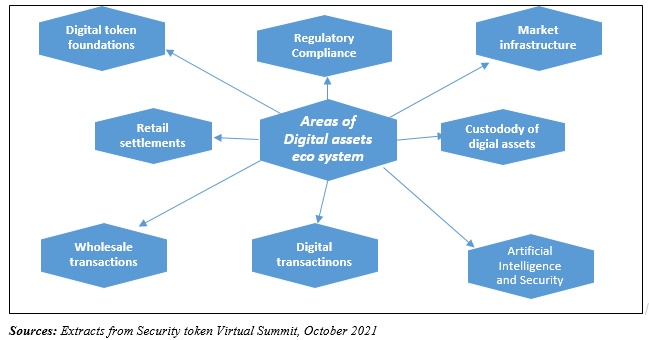Nov 15, 2021. According to International Monetary Fund October 2021 Global Financial Stability Report- Chapter 2: the Crypto Eco system and financial stability Challenges, the crypto assets market capitalisation has grown considerably with almost triple in 2021 $2.5 trillion. Crypto assets are enormous bouts of dangerous price volatility; during May 2021 40%, falls that concerns many institutional investors questioned the ecosystem. ECB Crypto-Assets Task force (May 2019), paper mentioned, “There is no international agreement how crypto-assets should be defined“. The paper denotes “Crypto-assets are any asset recorded in digital form that is not and does not represent either a financial claim on, or financial liability of, or any natural or legal person, and which does not embody a proprietary right against an entity.
(Quantifi Solutions 2021) defines “Crypto assets are digital assets which use cryptography techniques to generate a medium of exchange of financial transaction”. IMF discussed regulatory framework and critical issues with respect to digital assets and digital money, which includes fraud, integrity issues, Anti money laundering, Combating financing of terrorism, anonymity, decentralised control and other critical issue. There are new opportunities presents in the complex digital asset ecosystem, with this backdrop, it is most important to understand the various areas of eco system in the area of digital assets.
Digital Asset Eco system opportunity and key areas:
Diagram 1.1 Diagram showing key areas of Digital Asset Eco system

- Digital Tokens are mere digital representation of existing assets which allow recording assets using different technology. The major areas of digital token foundation consists of token infrastructure – physical and support infrastructure like intermediaries and international regulatory treatment of digital tokens , anonymity and privacy- ability of tokens privacy and the secured key, smart contracts – speed with efficient to ensure trust worthy and transparent predetermined block chain program and performance and scalability – ability to improve the overall performance and growth in digital token eco system
- Market infrastructure facilitates the tokens/ digital assets issuance or rollout to various investors – identifying markets for issue of stable token/debt/NFT , trading in digital assets – trading infrastructure for DeFI assets, post trade (clearing and settlement), risk management, collateral management and various exchange management – ability to manage the overall post trade management through moderated, intermediated hosted and validate.
- Regulatory compliance is the critical and most challenging area in the crypto assets domain, as there it involves cross border transactions without interference of Central bank. The main area covered included Anti money laundering, Fraud detection, regular audit of various parties involved in crypto asset transactions, regulatory reporting and ensure stability in the ecosystem.
- Custody is holding security whether in the form of Wallet or Distribute ledger technology. Unlike central bank issued money or any other forms of assets, digital assets prone for theft, misuse, losing keys and other cyber security issues. To address these challenges, digital asset custody area can be strengthened by secure key management, token issue management, reporting, digital identity (ISSN/CUSIP), corporate wallets and serving corporate action.
- Digital transaction with raise in many central bank issuing digital currency, the eco system needs development in digital transaction. The key areas includes; Central Bank Digital Currency and Private Digital currency , display of quotations – through regulated exchange or decentralised exchanges through alternative trading system, settlement services – integration with various decentralised network, resilience and disaster recovery system – cyber security and record keeping in case of malware or theft by hackers and Peer2Peer transaction management.
- Retail settlement, since the crypto asset do not any restriction of borders, it is most important to integrate and settlement management of the retail transaction. The key areas includes; universal access – ensure the access on real time basis, offline/online payment integration, anonymity and privacy issues management and high value transaction settlement.
- Wholesale transaction mainly large number of transactions across different jurisdictions of buying and selling will be executed using the Robo trading or Algorithm trading. These transactions can be settled using netting – process of obligation reduction by combining two or more position, which involves large number of transaction, Depository participant settlements and cross currency settlement.
- Real time Artificial intelligence using AI require additional compliance and monitoring as it generates large amount of data. The key areas includes; due diligence as per the regulatory requirements – to avoid artificial demand for the currency which supported by auditing requirements, financial crime management – although digital assets are anonymous and issue private keys it is require to know the investors identity as per Anti money laundering and combating of financing of terrorism, asset liability management and security assessment – mandatory security audit of all the Artificial intelligence transactions
Conclusion:
With rapid growth and volatility in the Crypto assets, there are new opportunities present in the ecosystem. Every central banks need to address numerous challenges in the Crypto asset management, as these assets are borderless transactions. Building a strong eco system facilitates the overall country economic development and management of ever changing industry. The key areas of digital asset eco system consists of digital token, market infrastructure, regulatory compliance, digital asset custody, digital transaction, retail settlement, wholesale transactions and real time Artificial Intelligence
Disclaimer – The views, opinions, and content on this blog are solely those of the authors. ISME does not take responsibility for the content, which is plagiarized or not quoted.



